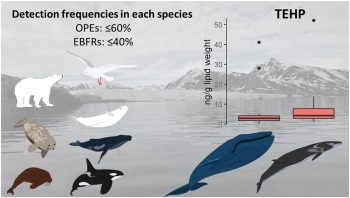12 October 2022: New paper on “Occurrence of emerging brominated flame retardants and organophosphate esters in marine wildlife from the Norwegian Arctic”
A new paper by Anna Lippold and co-authored by Scientific Committee member Christian Lydersen was recently published in Environmental Pollution analysing concentrations of brominated flame retardants (EBFR) and organophosphate esters (OPEs) in marine wildlife from the Norwegian Arctic.

Picture taken from paper
Flame retardants are used to reduce flammability of many consumer products, like furniture, textiles and electronics while OPEs are additionally used as plasticizers. They have toxic properties and are present worldwide, even in remote Arctic regions, which indicates both their persistence and capacity for long-range transport.
EBFRs were analysed in 157 blubber/adipose tissue sample of blue whales (Balaenoptera musculus), fin whales (Balaenoptera physalus), humpback whales (Megaptera novaeangliae), killer whales (Orcinus orca), white whales (Delphinapterus leucas), ringed seals (Pusa hispida), walruses (Odobenus rosmarus), polar bears (Ursus maritimus) and glaucous gulls (Larus hyperboreus). Additionally, OPEs were analysed in 34 blubber samples of blue whales, fin whales, and white whales. The tissue samples were collected in or around the Svalbard Archipelago and in coastal waters off northern Norway.
Tris(2-ethylhexyl) phosphate (TEHP) and tris(2-chloroisopropyl) phosphate (TCIPP) ranged from <0.61 to 164 and < 0.8–41 ng/g lipid weight, respectively, in blue whales and fin whales. All other EBRFs and OPEs were below the detection limit or detected only at low concentration.
Read the full study here: https://www.sciencedirect.com/science/article/pii/S0269749122016098


